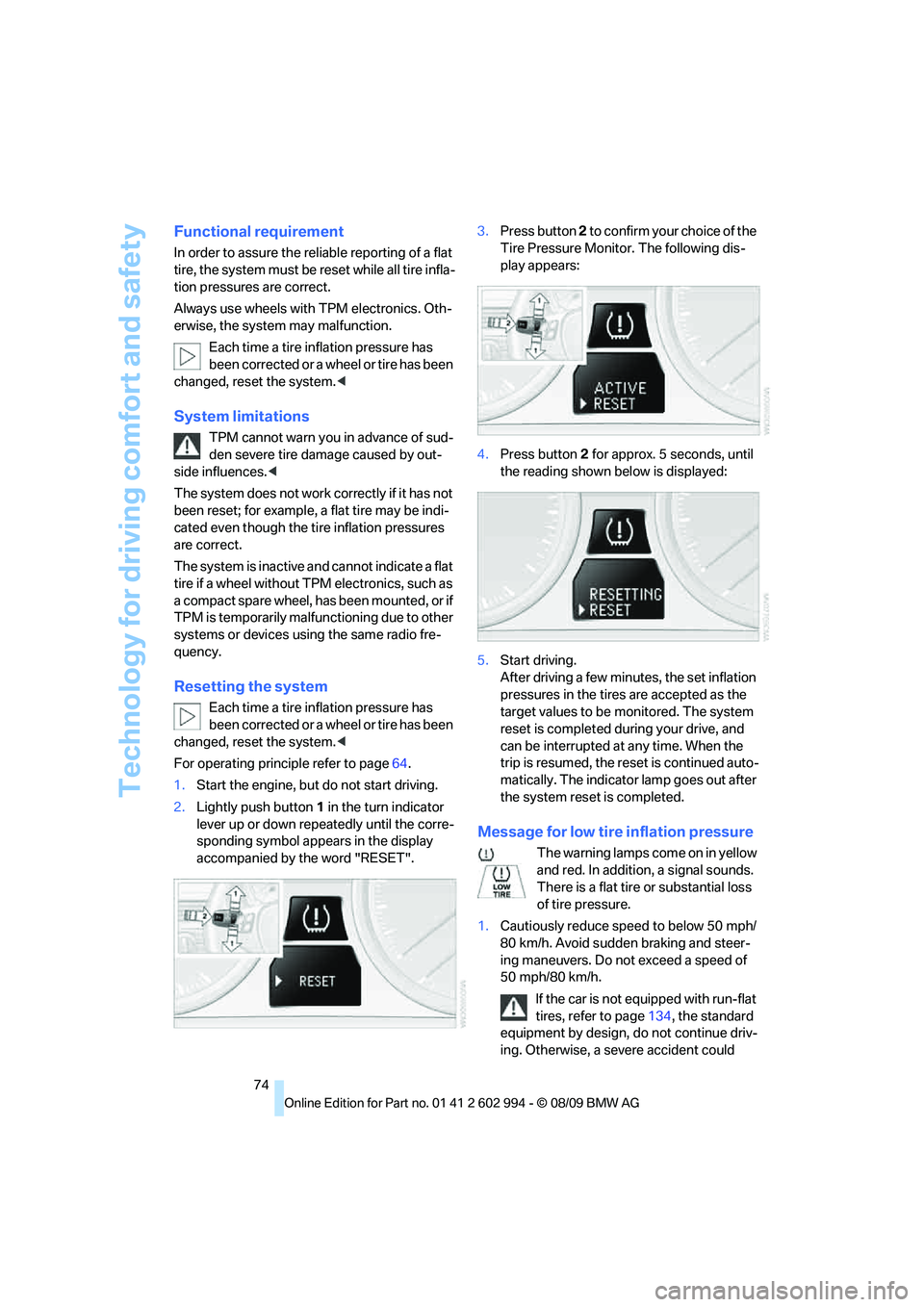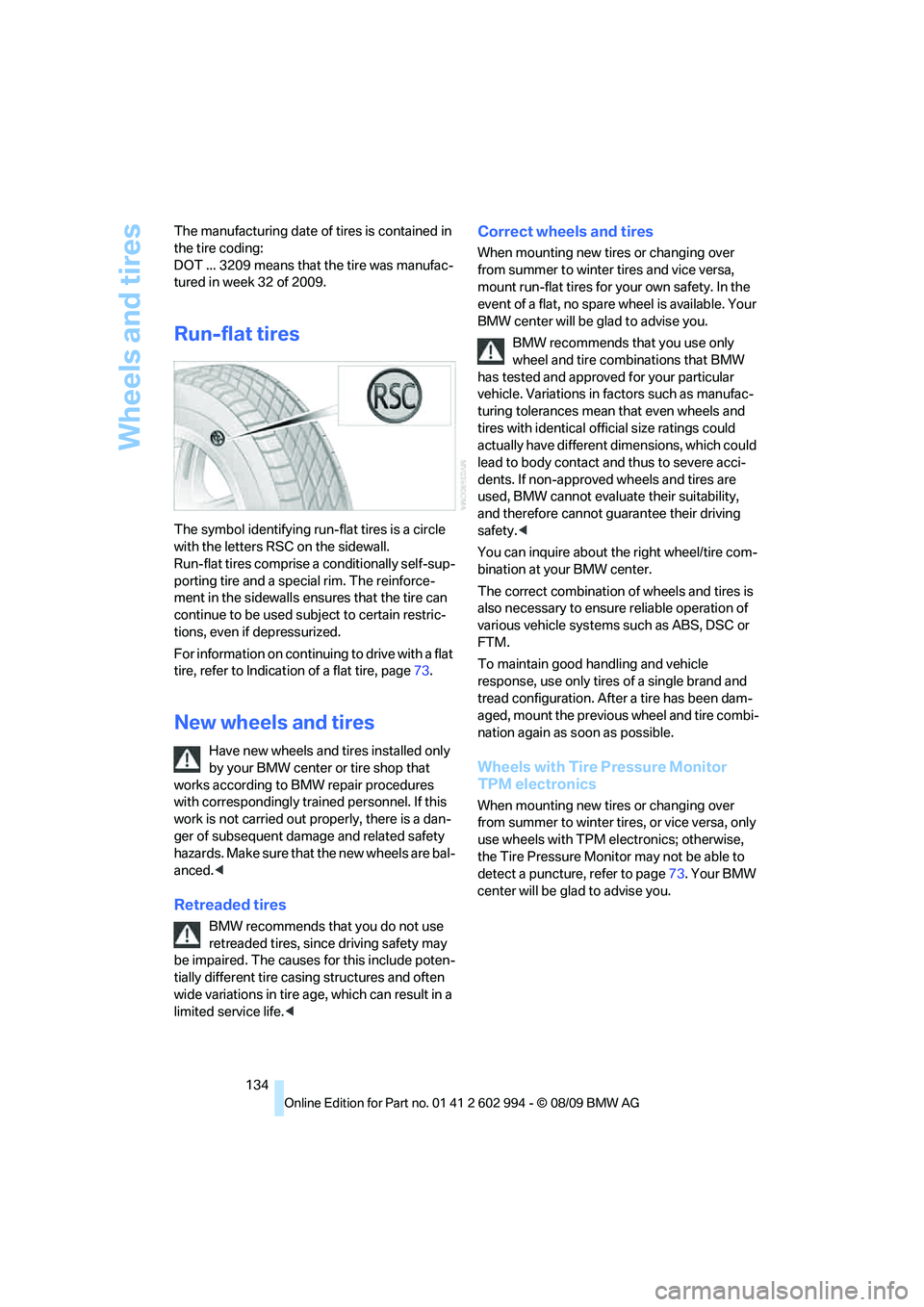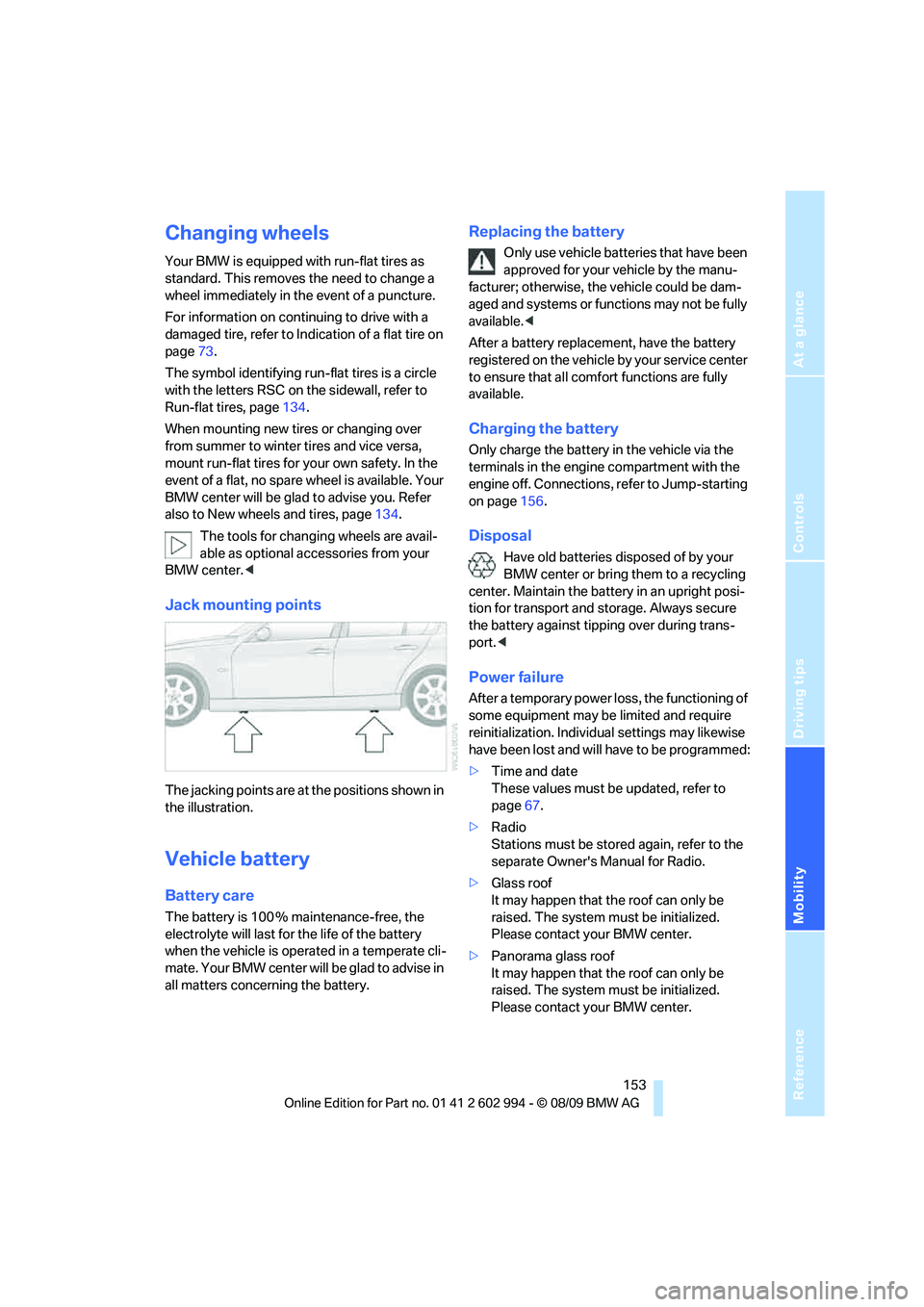2010 BMW M3 spare wheel
[x] Cancel search: spare wheelPage 76 of 196

Technology for driving comfort and safety
74
Functional requirement
In order to assure the reliable reporting of a flat
tire, the system must be reset while all tire infla-
tion pressures are correct.
Always use wheels with TPM electronics. Oth-
erwise, the system may malfunction.
Each time a tire inflation pressure has
been corrected or a wheel or tire has been
changed, reset the system.<
System limitations
TPM cannot warn you in advance of sud-
den severe tire damage caused by out-
side influences.<
The system does not work correctly if it has not
been reset; for example, a flat tire may be indi-
cated even though the tire inflation pressures
are correct.
The system is inactive and cannot indicate a flat
tire if a wheel without TPM electronics, such as
a compact spare wheel, has been mounted, or if
TPM is temporarily malfunctioning due to other
systems or devices using the same radio fre-
quency.
Resetting the system
Each time a tire inflation pressure has
been corrected or a wheel or tire has been
changed, reset the system.<
For operating principle refer to page64.
1.Start the engine, but do not start driving.
2.Lightly push button 1 in the turn indicator
lever up or down repeatedly until the corre-
sponding symbol appears in the display
accompanied by the word "RESET".3.Press button 2 to confirm your choice of the
Tire Pressure Monitor. The following dis-
play appears:
4.Press button 2 for approx. 5 seconds, until
the reading shown below is displayed:
5.Start driving.
After driving a few minutes, the set inflation
pressures in the tires are accepted as the
target values to be monitored. The system
reset is completed during your drive, and
can be interrupted at any time. When the
trip is resumed, the reset is continued auto-
matically. The indicator lamp goes out after
the system reset is completed.
Message for low tire inflation pressure
The warning lamps come on in yellow
and red. In addition, a signal sounds.
There is a flat tire or substantial loss
of tire pressure.
1.Cautiously reduce speed to below 50 mph/
80 km/h. Avoid sudden braking and steer-
ing maneuvers. Do not exceed a speed of
50 mph/80 km/h.
If the car is not equipped with run-flat
tires, refer to page134, the standard
equipment by design, do not continue driv-
ing. Otherwise, a severe accident could
Page 136 of 196

Wheels and tires
134 The manufacturing date of tires is contained in
the tire coding:
DOT ... 3209 means that the tire was manufac-
tured in week 32 of 2009.
Run-flat tires
The symbol identifying run-flat tires is a circle
with the letters RSC on the sidewall.
Run-flat tires comprise a conditionally self-sup-
porting tire and a special rim. The reinforce-
ment in the sidewalls ensures that the tire can
continue to be used subject to certain restric-
tions, even if depressurized.
For information on continuing to drive with a flat
tire, refer to Indication of a flat tire, page73.
New wheels and tires
Have new wheels and tires installed only
by your BMW center or tire shop that
works according to BMW repair procedures
with correspondingly trained personnel. If this
work is not carried out properly, there is a dan-
ger of subsequent damage and related safety
h a z a r d s . M a k e s u re t h a t t h e n e w w h ee l s a r e b a l-
anced.<
Retreaded tires
BMW recommends that you do not use
retreaded tires, since driving safety may
be impaired. The causes for this include poten-
tially different tire casing structures and often
wide variations in tire age, which can result in a
limited service life.<
Correct wheels and tires
When mounting new tires or changing over
from summer to winter tires and vice versa,
mount run-flat tires for your own safety. In the
event of a flat, no spare wheel is available. Your
BMW center will be glad to advise you.
BMW recommends that you use only
wheel and tire combinations that BMW
has tested and approved for your particular
vehicle. Variations in factors such as manufac-
turing tolerances mean that even wheels and
tires with identical official size ratings could
actually have different dimensions, which could
lead to body contact and thus to severe acci-
dents. If non-approved wheels and tires are
used, BMW cannot evaluate their suitability,
and therefore cannot guarantee their driving
safety.<
You can inquire about the right wheel/tire com-
bination at your BMW center.
The correct combination of wheels and tires is
also necessary to ensure reliable operation of
various vehicle systems such as ABS, DSC or
FTM.
To maintain good handling and vehicle
response, use only tires of a single brand and
tread configuration. After a tire has been dam-
aged, mount the previous wheel and tire combi-
nation again as soon as possible.
Wheels with Tire Pressure Monitor
TPM electronics
When mounting new tires or changing over
from summer to winter tires, or vice versa, only
use wheels with TPM electronics; otherwise,
the Tire Pressure Monitor may not be able to
detect a puncture, refer to page73. Your BMW
center will be glad to advise you.
Page 155 of 196

Reference
At a glance
Controls
Driving tips
Mobility
153
Changing wheels
Your BMW is equipped with run-flat tires as
standard. This removes the need to change a
wheel immediately in the event of a puncture.
For information on continuing to drive with a
damaged tire, refer to Indication of a flat tire on
page73.
The symbol identifying run-flat tires is a circle
with the letters RSC on the sidewall, refer to
Run-flat tires, page134.
When mounting new tires or changing over
from summer to winter tires and vice versa,
mount run-flat tires for your own safety. In the
event of a flat, no spare wheel is available. Your
BMW center will be glad to advise you. Refer
also to New wheels and tires, page134.
The tools for changing wheels are avail-
able as optional accessories from your
BMW center.<
Jack mounting points
The jacking points are at the positions shown in
the illustration.
Vehicle battery
Battery care
The battery is 100 % maintenance-free, the
electrolyte will last for the life of the battery
when the vehicle is operated in a temperate cli-
mate. Your BMW center will be glad to advise in
all matters concerning the battery.
Replacing the battery
Only use vehicle batteries that have been
approved for your vehicle by the manu-
facturer; otherwise, the vehicle could be dam-
aged and systems or functions may not be fully
available.<
After a battery replacement, have the battery
registered on the vehicle by your service center
to ensure that all comfort functions are fully
available.
Charging the battery
Only charge the battery in the vehicle via the
terminals in the engine compartment with the
engine off. Connections, refer to Jump-starting
on page156.
Disposal
Have old batteries disposed of by your
BMW center or bring them to a recycling
center. Maintain the battery in an upright posi-
tion for transport and storage. Always secure
the battery against tipping over during trans-
port.<
Power failure
After a temporary power loss, the functioning of
some equipment may be limited and require
reinitialization. Individual settings may likewise
have been lost and will have to be programmed:
>Time and date
These values must be updated, refer to
page67.
>Radio
Stations must be stored again, refer to the
separate Owner's Manual for Radio.
>Glass roof
It may happen that the roof can only be
raised. The system must be initialized.
Please contact your BMW center.
>Panorama glass roof
It may happen that the roof can only be
raised. The system must be initialized.
Please contact your BMW center.
Page 191 of 196

Reference
At a glance
Controls
Driving tips
Mobility
189
Seats34
– adjusting electrically34
– adjusting the seats34
– heating37
– memory, refer to Seat and
mirror memory37
– saving a setting, refer to Seat
and mirror memory37
– sitting safely33
Securing cargo101
Securing the vehicle
– from inside22
– from outside19
Selecting distance for active
cruise control56
Selector lever
– automatic transmission with
Steptronic49
Selector lever lock, refer to
Changing selector lever
positions, shiftlock49
Selector lever positions
– automatic transmission with
Steptronic49
Service, refer to Roadside
Assistance155
Service car, refer to Roadside
Assistance155
Service data in the remote
control141
Service Interval Display, refer
to Condition Based Service
CBS141
Service requirement display,
refer to Condition Based
Service CBS141
Service requirements65
Settings
– clock, 12h/24h format64
Settings and information64
Shifting gears
– automatic transmission with
Steptronic49
– manual transmission48
Shiftlock
– automatic transmission,
refer to Changing selector
lever positions49
Side airbags77Side window blind, refer to
Roller sun blinds94
Side windows, refer to
Windows28
Signal horn, refer to
Horn10,11
Sitting safely33
– with airbags33
– with head restraint33
– with safety belts33
Ski bag101
Sliding/tilt sunroof
– refer to Panorama glass
roof30
Sliding/tilt sunroof, refer to
Glass roof, electric29
Slot for remote control46
Smokers' package, refer to
Ashtray96
Snap-in adapter, refer to
Center armrest storage
compartment95
Socket, Onboard Diagnosis
OBD142
Socket, refer to Connecting
electrical appliances96
Soot particulate filter, refer to
Diesel particulate filter107
SOS, refer to Sending an
Emergency Request155
Spare fuses154
Speed
– run-flat tires73
– with winter tires135
Speedometer12
Split rear seat backrest, refer
to Expanding the cargo
area99
Spray nozzles, refer to
Cleaning windshield and
headlamps52
Stability control, refer to
Driving stability control
systems70
Start/stop button46
– starting the engine47
– switching off the engine47
Starting, refer to Starting the
engine47Starting assistance, refer to
Jump-starting156
Starting difficulties
– jump-starting156
Starting the engine
– start/stop button46
Status of this Owner's Manual
at time of printing5
Steam jet143,144
Steering wheel40
– adjustment40
– buttons on steering
wheel11
– heating41
– lock46
– locking with Comfort
Access27
Steering with variable ratio,
refer to Active steering76
Steptronic, refer to Automatic
transmission with
Steptronic48
Storage146
Storage compartments95
Storage nets100
Storing seat positions, refer to
Seat and mirror memory37
Storing tires135
Stowage, refer to Storage
compartments95
Summer tires, refer to Wheels
and tires119
Sun blinds94
Surface ice, refer to Outside
temperature warning61
Switches, refer to Cockpit10
Switching off
– engine47
Switching off the engine
– start/stop button46
Switching the cooling function
on and off89
Symbols4
T
Tachometer61